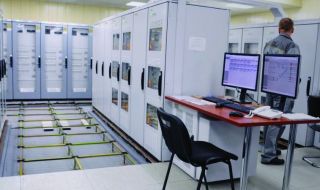An updated polymer gel from Argonne National Laboratory proves to be effective in removing radioactive contaminants from a legacy site.

The gel is applied to an area (left), where it is allowed to work for two to three hours before being removed. The final activity of the cleaned area (right) was counted using HPGe and Ludlum alpha/beta radiation detectors. Photos courtesy of ANL.
Current techniques for radiological decontamination often involve debasing or demolishing structures to contain contaminated dust and haul debris away. This is a costly method of decontaminating buildings and structures. If, however, effective nondestructive methods can be found, significant savings are possible. One such method, based on new research from engineers at the Department of Energy’s Argonne National Laboratory in Lemont, Ill., is now available.
The geologic repository for defense-related transuranic waste reached a milestone in 2019.
February 10, 2020, 7:38AMRadwaste SolutionsJef Lucchini, Robert Kehrman, and George Basabilvazo 
Participants to the 2017 Nuclear Criticality Safety Division topical meeting attended a tour of the WIPP facility, which marked its 20th anniversary this past year. Photos courtesy of WIPP
March 26, 2019, marked the 20th anniversary of the first shipment of transuranic (TRU) waste to the Waste -Isolation Pilot Plant (WIPP) facility in southeastern New Mexico. Celebrations of the 20-year mark of waste operations recognized the role of the WIPP facility in cleaning up legacy TRU waste from 22 generator sites nationwide.
The NWTRB offers findings and recommendations to the DOE on technical issues that need to be addressed in preparing for an integrated, nationwide program to transport nuclear waste.
The U.S. Nuclear Waste Technical Review Board (NWTRB or Board) recently completed an evaluation of Department of Energy activities related to transporting spent nuclear fuel (SNF) and high-level radioactive waste. These topics have been the subject of several Board meetings and associated reports, and in September 2019, the Board issued a report, Preparing for Nuclear Waste Transportation–Technical Issues That Need to Be Addressed in Preparing for a Nationwide Effort to Transport Spent Nuclear Fuel and High-Level Radioactive Waste [1], which focuses on the issues DOE will need to address to plan and implement an integrated transportation program. In its report, the Board describes 30 broad technical issues that DOE needs to address and offers three sets of findings and recommendations.




